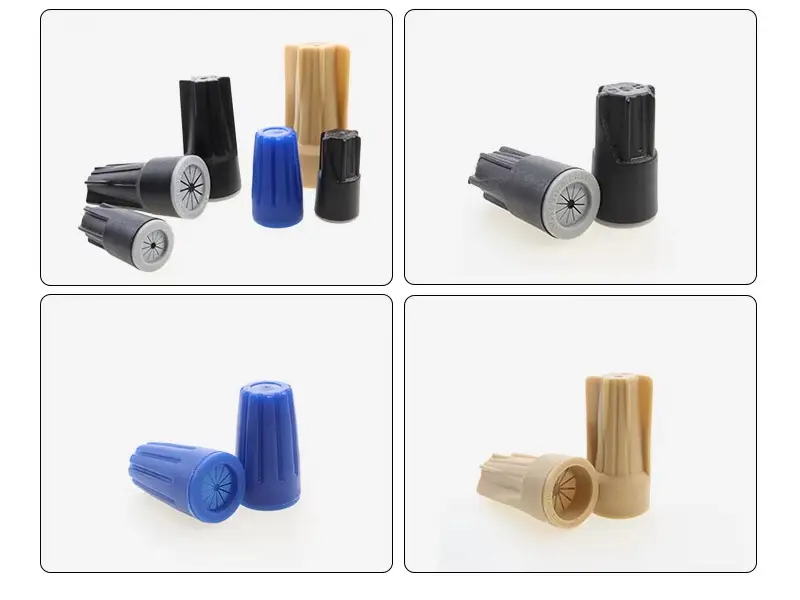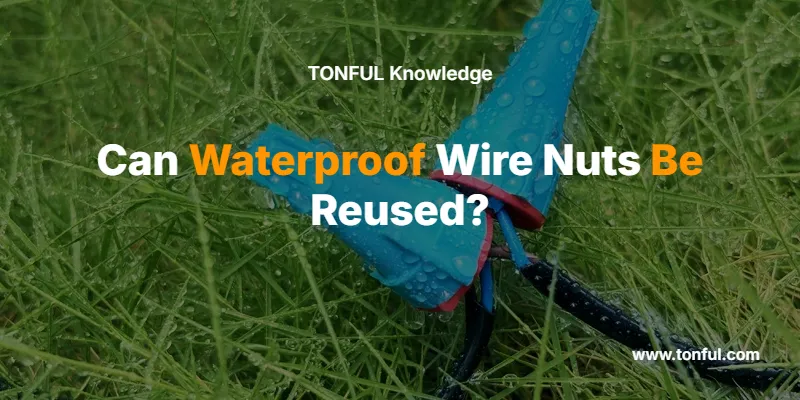Understanding when you can safely reuse waterproof wire connectors versus when replacement is mandatory protects your electrical systems from moisture damage, corrosion, and potential fire hazards while helping you work efficiently on projects.
What Are Waterproof Wire Nuts?

Waterproof wire nuts are electrical connectors specifically designed to create moisture-resistant connections in wet or outdoor environments. Unlike standard wire nuts, these connectors incorporate additional sealing mechanisms to prevent water intrusion that could cause shorts, corrosion, or electrical failures.
You’ll find waterproof wire nuts used in landscape lighting, outdoor receptacles, underground wiring, marine applications, and any location exposed to moisture, humidity, or direct water contact.
Key Differences: Reusable vs Single-Use Waterproof Connectors
Here is a table that shows the critical differences between reusable and single-use waterproof wire connectors:
| Feature | Reusable Waterproof Wire Nuts | Single-Use Gel-Filled Connectors |
|---|---|---|
| Sealing Method | Rubber gaskets, silicone rings, or threaded compression | Silicone gel permanently encapsulates wires |
| Reusability | 2-3 times with proper inspection | Never reusable once applied |
| Cost Per Unit | $1.50-$4.00 | $0.75-$2.00 |
| Installation | Twist-on with mechanical seal | Twist-on, gel flows to seal |
| Removal | Clean removal possible | Requires cutting wires |
| Water Resistance | IP67-IP68 rating when new | IP68 rating permanent seal |
| Best For | Temporary or serviceable connections | Permanent outdoor installations |
| NEC Compliance | Article 110.14(B) if properly rated | Article 110.14(B) compliant |
Expert Tip: Always check the manufacturer’s specifications before reusing any waterproof connector. Some premium brands like King Innovation’s WeatherProof and Ideal’s In-Sure connectors explicitly state reusability limits.
When You Can Safely Reuse Waterproof Wire Nuts
You can reuse waterproof wire nuts when all these conditions are met:
1. Connector Type Verification
You must confirm the connector uses mechanical sealing (rubber gaskets or compression threads) rather than permanent gel filling. Check the packaging or manufacturer documentation for reusability statements.
2. Physical Inspection Requirements
Before reusing any waterproof wire nut, inspect for:
- No visible cracks or splits in the plastic housing
- Intact sealing gasket with no tears, compression set, or deformation
- Clean threads without cross-threading or stripped areas
- No corrosion on internal metal components
- Proper spring tension in twist-on mechanisms
- Clear manufacturer markings still legible
3. Functional Testing Protocol
After visual inspection, test the connector’s integrity:
- Twist the connector onto spare wire of the same gauge
- Check for smooth, firm threading with resistance
- Verify the gasket compresses evenly around the wire bundle
- Confirm no wobble or loose fit when properly tightened
4. Maximum Reuse Guidelines
Here is a table showing recommended reuse limits by connector type:
| Connector Type | Maximum Reuses | Conditions |
|---|---|---|
| Premium mechanical seal (King Innovation, 3M DBR/Y) | 3-4 times | With perfect inspection results |
| Standard silicone ring seal | 2-3 times | No visible gasket compression |
| Basic rubber gasket | 1-2 times | Replace gasket after each use |
| Gel-filled (any brand) | 0 times | Never reusable |
| Heat-shrink connectors | 0 times | Never reusable |
Safety Warning: Even if a waterproof wire nut passes visual inspection, always replace it if it will be used in critical applications like main service connections, circuits over 20 amps, or permanently buried installations. The cost of a new connector ($2-4) is negligible compared to troubleshooting water-damaged circuits.
When You Must Replace Waterproof Wire Nuts
You must never reuse waterproof wire nuts in these situations:
Critical Safety Scenarios
Immediate Replacement Required:
- Any visible damage to housing, threads, or sealing components
- Previous exposure to excessive heat (above 194°F/90°C)
- Connectors that leaked or failed in prior installations
- Age exceeding manufacturer’s shelf life (typically 5-10 years)
- Connectors from circuits that experienced shorts or faults
- Any gel-filled or heat-shrink type connector
Installation Environment Factors
Replace rather than reuse when the application involves:
- Permanent burial underground without access boxes
- Direct burial in concrete or within structural elements
- Submersible applications like fountain or pond wiring
- High-vibration environments such as machinery connections
- Critical circuits including main service, GFCI, or AFCI protection
- Lightning-prone areas requiring maximum connection integrity
Expert Tip: The National Electrical Code (NEC) Article 110.14(B) requires all connections to maintain conductor ampacity. Reused connectors with compromised seals may not meet this requirement in wet locations per NEC 300.5 and 300.9.
How to Properly Reuse Waterproof Wire Nuts
If your inspection confirms safe reusability, follow this step-by-step process:
Step 1: Clean the Connector Thoroughly
- Remove all wire strands and debris from interior threads
- Wipe gasket surfaces with isopropyl alcohol
- Inspect under bright light for hidden cracks
- Allow complete drying before reuse
Step 2: Prepare Wires Correctly
- Strip wire insulation to manufacturer’s specified length (typically 5/8″)
- Ensure all conductors are same gauge as original application
- Twist copper strands tightly to prevent fraying
- Confirm wire count matches connector capacity
Step 3: Apply Proper Installation Technique
- Insert wires until they bottom out against internal stop
- Twist connector clockwise with firm, steady pressure
- Continue twisting until resistance significantly increases
- Verify wires cannot be pulled out with moderate force
Step 4: Seal Verification
- Check that gasket compresses evenly around wire bundle
- Confirm no gaps between connector body and wires
- Apply manufacturer’s recommended sealant if specified
- Tag connection with reuse date and count
Expert Tip: Professional electricians often apply a small amount of dielectric grease to reused gaskets to restore flexibility and improve sealing performance. Use only products rated for electrical applications.
What Makes Waterproof Wire Nuts Different from Standard Connectors?
Waterproof wire nuts incorporate specialized design features beyond basic twist-on connectors:
Sealing Technology Comparison
Standard Wire Nuts:
- Tapered metal spring provides mechanical connection only
- Plastic shell offers minimal moisture protection
- Rated for dry and damp locations only
- No gasket or seal components
- Cost: $0.10-$0.50 each
Waterproof Wire Nuts:
- Include rubber/silicone gaskets or gel filling
- Provide compression seal around wire entry points
- Rated IP67 (submersion resistant) or IP68 (continuous submersion)
- Meet wet location requirements per NEC 300.9
- Cost: $0.75-$4.00 each
The waterproof rating translates to real protection: IP67 means submersion in 1 meter of water for 30 minutes, while IP68 indicates continuous submersion capability at depths specified by the manufacturer.
Choosing Between Reusable and Single-Use Waterproof Connectors
Here is a decision-making guide for selecting the right connector type:
Choose Reusable Mechanical Seal Connectors When:
- You anticipate future modifications or troubleshooting access
- Working on temporary installations or testing setups
- Budget allows for higher upfront investment ($2-4 per connector)
- Installation includes accessible junction boxes or service points
- Local codes permit serviceable connections in your application
- You need to make seasonal changes (landscape lighting adjustments)
Choose Single-Use Gel-Filled Connectors When:
- Making permanent installations with no planned service access
- Direct burying connections where moisture protection is critical
- Working with budget constraints on large-scale projects
- Installing in harsh marine or continuously wet environments
- Local codes require permanent moisture barriers
- Connection will remain undisturbed for system lifetime
Expert Tip: For landscape lighting and other accessible outdoor circuits, use reusable connectors in junction boxes and single-use gel-filled connectors only for direct-burial splice points. This strategy balances serviceability with maximum protection where it matters most.
Safety Considerations and Code Compliance
NEC Requirements for Wet Location Connections
The National Electrical Code establishes specific requirements for connections in wet locations:
- Article 110.14(B): Splices must maintain conductor ampacity
- Article 300.5(B): Underground splices require approved methods
- Article 300.9: Requires raceways and cables in wet locations to prevent moisture accumulation
- Article 406.9: Wet location receptacles need weatherproof covers
Any reused waterproof wire nut must still meet these requirements. A compromised seal violates code and creates liability.
Critical Safety Warnings
Electrical Shock Hazard: Never work on energized circuits. Always turn off power at the breaker, verify with a non-contact voltage tester, and follow OSHA lockout/tagout procedures when working on circuits others might access.
Fire Risk: Loose connections from degraded reused connectors can generate heat leading to insulation damage or fire. Studies show connection failures cause approximately 20% of residential electrical fires.
Corrosion Damage: Water intrusion through compromised seals causes galvanic corrosion in dissimilar metal connections (copper to aluminum). This increases resistance, generates heat, and can lead to complete connection failure.
Professional Requirement: Some jurisdictions require licensed electricians to make all outdoor electrical connections. Check local requirements before attempting DIY electrical work.
Troubleshooting Common Waterproof Wire Nut Problems
Problem: Connector Won’t Tighten Properly on Reuse
Likely Causes:
- Gasket has taken compression set from previous use
- Threads damaged during removal
- Wrong wire gauge for connector size
- Internal spring fatigued
Solutions:
- Replace gasket if removable, otherwise discard connector
- Verify wire gauge matches connector rating
- Use new connector if threads show any damage
- Check for debris preventing full insertion
Problem: Water Found Inside Junction Box
Likely Causes:
- Reused connector seal has failed
- Insufficient wire insertion depth
- Missing or damaged box gaskets
- Inadequate sealant application
Solutions:
- Replace all connectors in affected box
- Verify wires bottom out in connector cavity
- Use weatherproof box with proper gaskets
- Apply NEC-compliant sealant to all entry points
Problem: Corrosion on Wire Ends After Reuse
Causes and Prevention:
- Previous water intrusion wasn’t detected during inspection
- Connector seal compromised during reinstallation
- Dissimilar metals without proper protection
Corrective Actions:
- Cut back wires past corroded section
- Replace connector with appropriately rated new unit
- Apply anti-oxidant compound to aluminum connections
- Consider upgrading to higher IP-rated connectors
Cost-Benefit Analysis: Reusing vs Replacing
Here is a practical cost comparison for typical applications:
| Scenario | Reusable Connector Cost | Single-Use Connector Cost | Best Choice | Rationale |
|---|---|---|---|---|
| 10-light landscape system (20 connections) | $60 initial, $0 maintenance | $20 initial, $20 per change | Reusable | Frequent seasonal adjustments expected |
| Permanent deck lighting (8 connections) | $24 initial, $0 maintenance | $8-16 initial | Single-use | Set-and-forget installation |
| Outdoor outlet circuit (4 connections) | $12 initial | $4-8 initial | Reusable | Serviceability required by code in accessible box |
| Underground dog fence (50+ connections) | $150+ initial | $50-75 initial | Single-use | Permanent installation, cost sensitive |
Expert Tip: Calculate your breakeven point. If you’ll service connections more than twice over their lifetime, reusable connectors pay for themselves. For one-time installations, single-use connectors offer better value.
Frequently Asked Questions
Can you reuse waterproof wire nuts that still look good?
Yes, but only after thorough inspection. Check the gasket for compression set (permanent deformation), inspect threads for damage, and verify no cracks in the housing. Test the seal by twisting onto spare wire to confirm proper compression. Even good-looking connectors should not exceed 2-3 reuses.
How many times can premium waterproof wire nuts be reused?
Premium mechanical seal connectors from brands like King Innovation WeatherProof or 3M Performance Plus can typically be reused 3-4 times if they pass inspection each time. Standard connectors should be limited to 2-3 reuses. Always follow manufacturer specifications when provided.
Are gel-filled wire nuts ever reusable?
No, gel-filled wire nuts are never reusable. The silicone gel permanently flows around and encapsulates the wires, making clean removal impossible without cutting the wires. These connectors are designed for permanent installations only.
Can you reuse waterproof wire nuts in direct burial applications?
It is not recommended to reuse any waterproof wire nut in direct burial applications. The risk of seal failure underground where you cannot easily inspect or repair the connection is too high. Always use new, rated direct-burial connectors (UF or UL listed) for underground installations per NEC 300.5.
Do waterproof wire nuts expire if never used?
Yes, rubber and silicone gaskets can degrade over time even when stored. Most manufacturers specify a 5-10 year shelf life. Check for gasket flexibility, any cracking, or hardening before using old stock. Heat and UV exposure accelerate aging.
What’s the difference between damp-rated and wet-rated wire nuts?
Damp-rated connectors protect against condensation and humidity but cannot withstand direct water exposure or submersion. Wet-rated (IP67/IP68) waterproof wire nuts can handle direct rain, splashing, or temporary submersion. Only use wet-rated connectors for outdoor exposed locations per NEC 300.9.
Should you add extra waterproofing to reused wire nuts?
Adding dielectric grease to gaskets can restore flexibility on reused connectors. Some electricians also wrap reused connectors with self-fusing silicone tape for additional protection. However, these measures cannot compensate for damaged seals or cracked housings. If extra waterproofing seems necessary, replace the connector instead.
Can waterproof wire nuts be used with aluminum wire?
Only use waterproof wire nuts specifically rated AL/CU (aluminum-copper) for aluminum wire connections. Most standard connectors are copper-only. Aluminum requires anti-oxidant compound and connectors designed to prevent galvanic corrosion. Check for UL listing and proper rating before use.
Quick Reference Guide: Waterproof Wire Nut Reusability Checklist
Before Reusing – Inspection Requirements:
- ✓ Verify mechanical seal type (not gel-filled)
- ✓ No cracks, splits, or housing damage
- ✓ Gasket intact without tears or permanent compression
- ✓ Threads clean and undamaged
- ✓ Internal components free of corrosion
- ✓ Manufacturer’s markings legible
- ✓ Previous use count under 3 times
- ✓ Not from failed or shorted circuit
Never Reuse When:
- ✗ Gel-filled or heat-shrink type
- ✗ Any visible damage present
- ✗ Direct burial application
- ✗ Critical circuit connection
- ✗ Connector age over 5 years
- ✗ Previous water intrusion detected
- ✗ Required for permanent installation
Proper Reuse Process:
- Clean thoroughly with isopropyl alcohol
- Inspect under bright light
- Test fit on spare wire
- Apply dielectric grease to gasket
- Install per manufacturer specifications
- Verify seal compression
- Tag with reuse date and count
The Bottom Line: When to Reuse Waterproof Wire Nuts
You can safely reuse waterproof wire nuts with mechanical seals 2-3 times for accessible, serviceable connections after passing rigorous inspection. For permanent installations, direct burial, or critical circuits, always invest in new connectors to ensure maximum safety and code compliance.
The small cost of replacement connectors ($2-4) provides insurance against water damage, electrical failures, and potential fire hazards that far exceed the savings of reuse. When in doubt, replace rather than reuse.
Professional Recommendation: Keep a supply of both reusable mechanical seal connectors for junction boxes and single-use gel-filled connectors for permanent splices. This approach gives you flexibility for troubleshooting while ensuring critical connections have maximum protection. Always consult a licensed electrician for complex installations or when local codes require professional work.
For the best long-term reliability in outdoor electrical systems, prioritize safety and code compliance over short-term cost savings. Your electrical system’s integrity depends on the quality of every connection.

